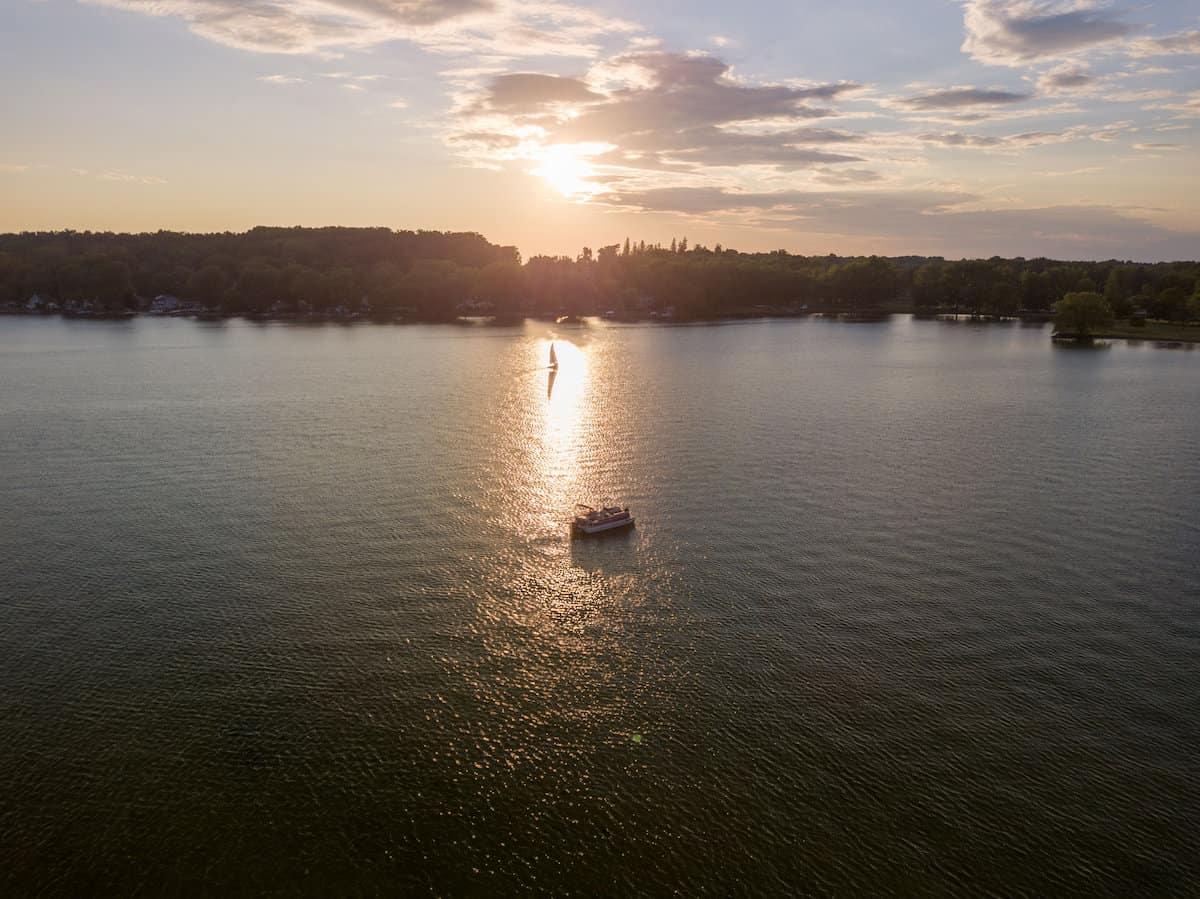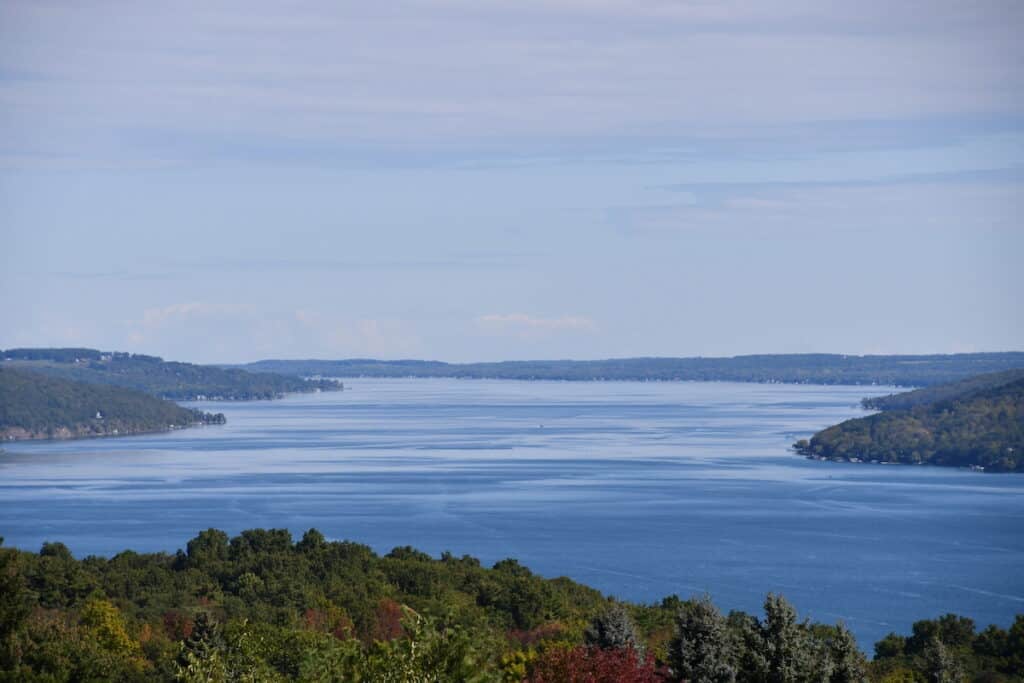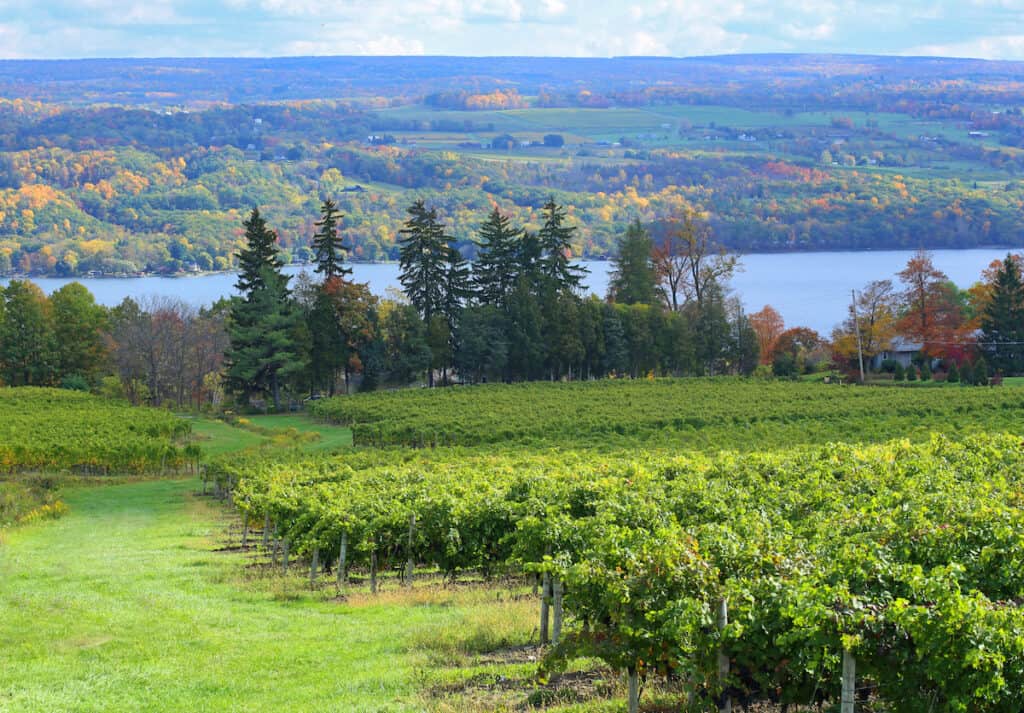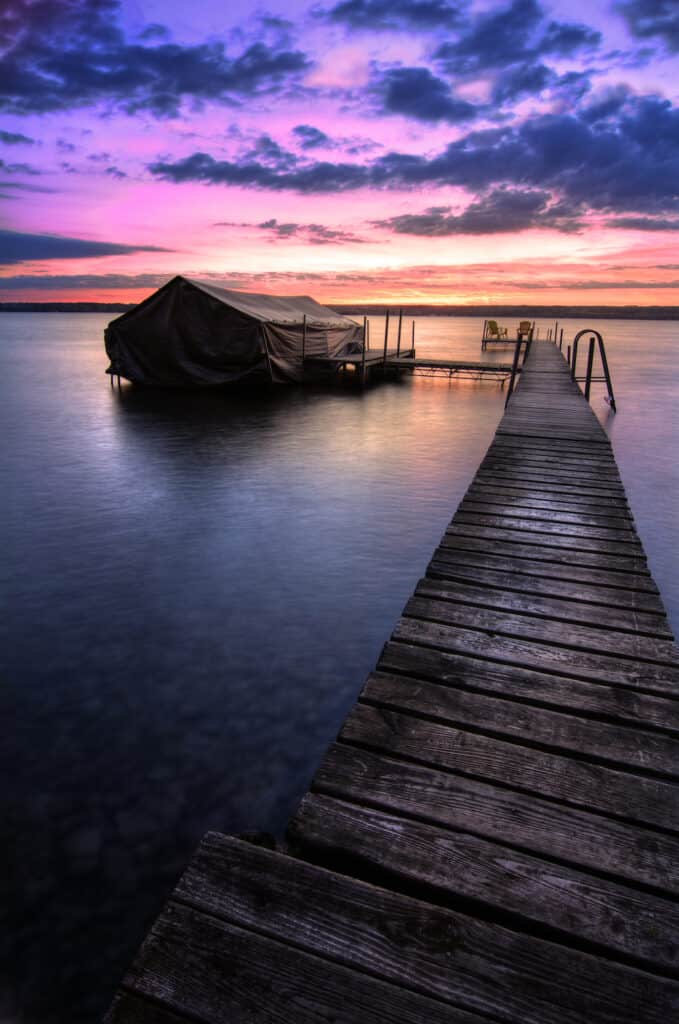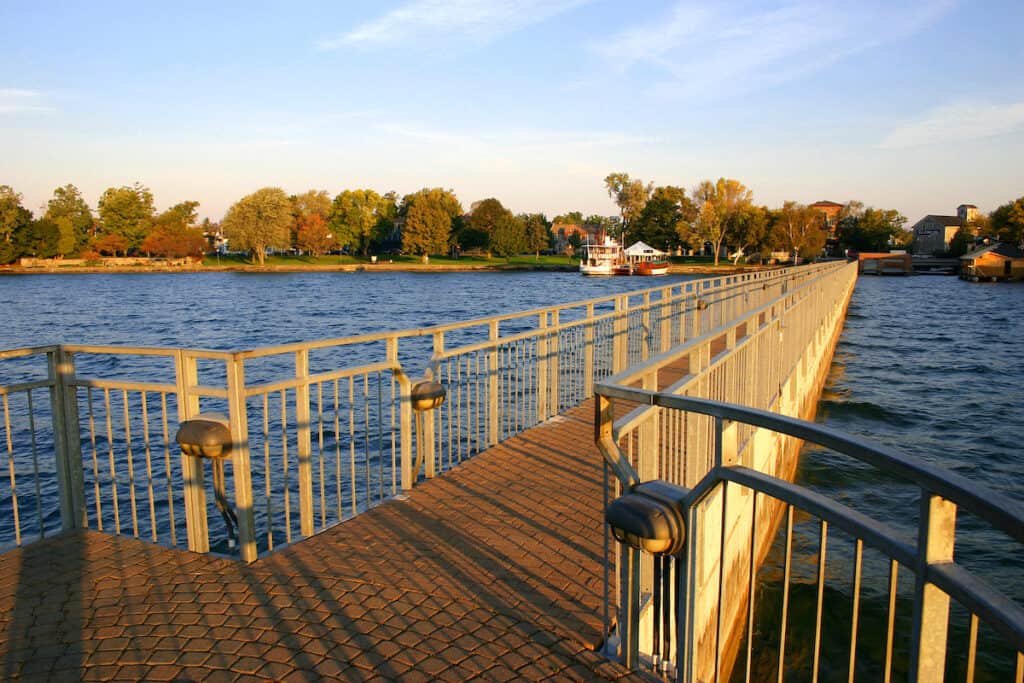Spread across Central New York like the fingers of two giant hands, the Finger Lakes provide unparalleled fishing opportunities. Some of the best fishing in the Empire State can be found here, from trout and salmon to bass and panfish.
The Finger Lakes region is known for its abundant wineries and craft breweries as well as its great fishing. The area is within a day’s drive of anywhere in New York—less than an hour from Rochester or Syracuse, and about four hours from New York City.
Though they vary greatly in size and depth, the Finger Lakes are, for the most part, geologically similar. Glaciers scoured out the entire chain about 10,000 years ago.
The Finger Lakes are long and narrow, each one generally oriented north to south. Typical Finger Lakes structure includes a deep main basin with steep drop-offs along the east and west sides, with shallower flats at the north and south ends.
Finger Lakes Bass and Walleye Fishing
All of the Finger Lakes provide fishing opportunities for warm water species, though no two lakes are alike.
Black bass are available in all of the Finger Lakes, with some being dominated by smallmouths and others by largemouths. An 8-pound, 6-ounce state record smallmouth bass was caught in Cayuga Lake in 2022.
Otisco, Honeoye and Conesus lakes have healthy walleye populations, while Cayuga, Seneca, Owasco and Conesus are known to produce northern pike over 20 pounds.
Seneca, Cayuga, Skaneateles and Keuka lakes are all great options for yellow perch, while Honeoye and Canandaigua are arguably the best of the lot for crappies.
Bluegill and sunfish are everywhere, with Honeoye and Cayuga being especially good for bigger bluegill.
Species like carp and sheepshead, though considered “rough fish” by many, are also common throughout the Finger Lakes.
Channel catfish, while not common in any of the Finger Lakes, are abundant in the adjoining Cayuga/Seneca Canal system.
Finger Lakes Trout and Salmon Fishing
Most of the Finger Lakes are deep and cool enough to support healthy two-story fisheries that include a variety of cold-water game fish. Salmonids such as lake, rainbow and brown trout are available in nine of the 11 finger lakes.
The two largest lakes, Seneca and Cayuga, offer the best opportunities for these species, especially for larger lake trout. Fishing for landlocked Atlantic salmon is also excellent in Seneca and Cayuga lakes.
Keuka Lake supports an abundant lake trout population, too, and is a great place to fish if you’re more interested in numbers than size. Skaneateles Lake and Canandaigua Lake are good bets for rainbow trout.
There is also excellent trout fishing in many Finger Lakes tributaries, especially in spring when rainbow trout make their annual spawning run.
Naples Creek (Canandaigua Lake), Catharine Creek (Seneca Lake), and Grout Brook (Skaneateles Lake) are all great spring trout streams.
Finger Lakes Ice Fishing
The largest of the Finger Lakes seldom freeze over completely. But the smaller lakes do, and almost every lake in the chain offers at least some ice cover that makes ice fishing a possibility.
In most of the Finger Lakes, the best ice fishing is at the relatively shallow north and south ends.
Honeoye Lake is one of the lakes best known for ice fishing, and anglers commonly catch pickerel and panfish. Conesus Lake also offers excellent panfish action through the ice.
Ice anglers commonly catch lake trout at Skaneateles and Keuka lakes, as well as Seneca and Cayuga, when conditions allow.
There is also excellent ice fishing elsewhere in the Finger Lakes region in lakes that are not technically considered part of the chain. Nearby Oneida Lake is a major ice fishing hub, as are many of Lake Ontario’s bays.
Where to Fish in the Finger Lakes
Four-season fishing is available throughout the Finger Lakes, with every lake offering its own unique fishing opportunities.
From west to east, here’s what you can expect when you fish each of the Finger Lakes.
Conesus Lake
The westernmost of the Finger Lakes, Conesus Lake is also one of the smaller lakes in the chain at 3,420 acres. It’s an excellent warm-water fishing lake, and also a popular spot for ice fishing.
Largemouth bass dominate catches, with an impressive abundance of healthy 3-pound fish. Largemouths up to 6 pounds are not uncommon. Smallmouths are also available but are less numerous.
Most of the lakeshore is developed and privately owned, and there are hundreds of boat docks along the east and west sides. Casting around docks is a reliable pattern for spring largemouth bass fishing, and weed beds are also productive as they develop in summer.
Excellent bank fishing access is available at Vitale Park, at the north end of the lake in Lakeville. A public boat launch is on East Lake Road, just south of the lake’s narrowed midpoint at McPherson Point.
Some very large walleye and pike live in Conesus Lake. They can be observed spawning in the Conesus Lake Inlet in April, and some quality fish are caught once the season opens in May.
Conesus Lake also offers great fishing for bluegill and sunfish through the ice, and during summer when they spawn on the sandy flats in vast colonies.
Bullhead spawn in the inlet every April and reliably attract a crowd of local anglers.
Hemlock Lake
Hemlock Lake, along with neighboring Canadice Lake, is one of only two Finger Lakes that have wooded, virtually undeveloped shorelines. The lake is used as a drinking water source for the city of Rochester, and is known for its pristine water.
This setting affords anglers a unique opportunity to fish in relative quiet and solitude. Boat motors are restricted to 10 hp, and two unimproved gravel launch ramps are located near the north and south ends of the lake.
Although small in size at 1,800 acres, Hemlock Lake is 90 feet deep, which allows it to support a two-story fishery. Rainbow trout, lake trout, brown trout and landlocked salmon are all available, though they run smaller than in some of the larger lakes.
Anglers commonly troll for trout and salmon or jig for them through the winter ice.
Warm water species, including largemouth and smallmouth bass, yellow perch, bluegill and pumpkinseed sunfish, are also available.
Anglers also know Hemlock Lake for its abundant chain pickerel, which are most common in the weed beds at the south end of the lake.
Canadice Lake
Bullhead fishing is locally popular, especially in early spring.
Access is through Hemlock-Canadice State Forest.
The smallest of the Finger Lakes at 649 acres, Canadice Lake has a lot in common with nearby Hemlock Lake. Surrounded by mostly undeveloped forest, the lake is almost certainly the least-fished of the Finger Lakes.
Smallmouth bass, lake trout and brown trout are the primary game fish in Canadice Lake. All three species thrive in the lake’s cool waters and abundance of rocky habitat, and can be caught year-round.
Due to the steepness of its east and west sides, Canadice has limited shallow habitat. Only a narrow fringe of vegetation runs parallel to the lakeshore, beyond which the sides drop steeply to a depth of 95 feet.
The most extensive weed beds are located at the south and of the lake. This area supports solid populations of largemouth bass, pickerel, black crappie and sunfish.
Like its neighbor, Canadice Lake is accessible through Hemlock-Canadice State Forest. Boats are limited to 10 hp.
Canadice Road, which runs along the east side of the lake, includes several bank access sites and an unimproved gravel boat launch.
Honeoye Lake
1,772-acre Honeoye Lake is the second-smallest Finger Lake, and at just 30 feet, it is by far the shallowest. It’s a highly-regarded fishing lake that offers outstanding angling for warm water species.
Natural populations of largemouth bass, smallmouth bass and chain pickerel are the dominant game fish in the lake, along with walleye, which have been stocked by the DEC for many years.
Hemlock Lake has developed into one of the better walleye fisheries in the Finger Lakes.
It’s also one of the better crappie lakes, with lots of 9- to 12-inch black crappies caught every spring. Other panfish, including bluegill, pumpkinseed, yellow perch and rock bass, are also caught through the ice and during the open water months.
Abundant weed beds start to develop every spring, with eelgrass, pondweed, water stargrass and Eurasian milfoil growing prolifically to a depth of about 15 feet. Fishing weed edges is the best tactic for bass and pickerel.
Anglers also flock here in the middle of winter because Honeoye is among the best ice fishing lakes in the state.
The Honeoye Lake State Boat Launch provides launch facilities and bank access at the south end of the lake, while Sandy Bottom Park offers bank fishing at the north end.
Canandaigua Lake
Canandaigua Lake spans 10,558 acres, making it the fourth-largest of the Finger Lakes. It’s a deep, clear lake with healthy populations of several cold and warm-water game fish.
Lake trout and brown trout populations are maintained through annual stocking by the DEC.
Rainbow trout are self-sustaining here, and Canandaigua Lake has developed a reputation as one of the best rainbow trout fisheries in the Finger Lakes.
That’s especially apparent during the month of April, when rainbows make their spawning run up Naples Creek at the south end of the lake. Some beautiful 18- to 22-inch lake trout are also caught by trolling along drop-offs on the main lake.
Rooted weed growth is largely limited to the shallow areas at the north and south ends of Canandaigua Lake. These areas support solid populations of largemouth and smallmouth bass, the latter being more common.
Bass anglers also do well around docks and boathouses.
The shallow ends of this lake also support some of the better crappie angling in New York.
The lakeshore is highly developed, including many large vacation homes. Boat traffic can be heavy on summer weekends.
A complex of parks at the north end of the lake, including Kershaw Park, the Canandaigua City Pier and Canandaigua Lake State Marine Park, provide bank and boat access.
Additional public launch sites are located on the west side and at the south end of the lake.
Keuka Lake
Keuka Lake is unique among the Finger Lakes in that it’s shaped like the letter Y, making it the only lake in the chain that can be said to have two branches. The lake offers 11,584 acres of water and stretches just over 19 miles end-to-end.
Lake trout are the main attraction at Keuka Lake, and anglers catch lots of them by trolling and jigging in the Hammondsport arm (i.e. the “stem” of the letter Y) and off Bluff Point, which divides the two upper branches.
Rainbow trout, landlocked salmon and brown trout have also been stocked, though anglers catch them less regularly. Browns over 20 pounds have been caught here in the past.
Trout are often caught surprisingly close to shore in spring and fall, thanks to the lake’s steep drop-offs.
Keuka Lake also supports plenty of warm water species. Some of the largest pickerel in the Finger Lakes are caught here, and yellow perch fishing can be excellent in shallower areas.
Perch fishing is especially good through the ice. The whole lake doesn’t usually freeze over, but the Pen Yann branch provides safe ice most years, and ice anglers catch perch along with pickerel and lake trout.
Keuka Lake also supports largemouth and smallmouth bass and has been noted for producing some truly massive bass. Largemouths over 7 pounds, while not common, are possible.
Access sites include Keuka State Park and a handful of public launch ramps.
Keuka Lake’s unique shape and the positioning of the surrounding hills help block it from strong winds, so it’s an alternative on days when neighboring Seneca Lake is too rough.
Seneca Lake
Seneca Lake encompasses 43,343 acres, stretching 38 miles long and reaching depths of 618 feet. That makes it the largest Finger Lake by surface area and also the deepest.
Geographically, it is right at the center of the chain.
Seneca Lake has historically offered some of the best cold water fishing in the Finger Lakes, especially for lake trout. Lakers weighing 20 pounds or more are possible here, and there are some massive rainbow and brown trout as well.
In recent years, lake trout numbers have taken a dip, probably due to the presence of invasive sea lampreys, which prey on trout. Catches of landlocked Atlantic salmon have increased as lake trout have declined.
As the DEC continues to battle the lampreys, expect the situation to continue to be in flux. All the same, the overall fishing for salmonids in Seneca Lake continues to be good.
Spring and fall offer the best trout and salmon fishing. Salmon often strike spoons and stickbaits trolled just below the surface, while lake trout favor deeper water, and trolling with divers or downriggers is typically required.
Fishing for warm water species is also very good here. For example, Seneca Lake produces some of the biggest northern pike in the Finger Lakes, with fish over 36 inches in the weed beds around the lake’s perimeter.
Smallmouth bass fishing is also excellent, and largemouths appear to be increasingly common in shallow, weedy areas.
The lakefront park and fishing pier in Watkins Glen, at the south end of the lake, is a great bank fishing spot for bass, pike and panfish.
Several state parks, including Seneca Lake State Park at the north end of the lake and Lodi Point State Park on the east shore, offer excellent boat launch facilities and bank access.
More: Complete Guide to Seneca Lake Fishing
Cayuga Lake
Only slightly smaller than neighboring Seneca Lake, Cayuga Lake’s 42,956 acres provide what quite a few anglers consider the best fishing in the Finger Lakes.
An equally wide range of species call it home, and its somewhat less steep drop-offs make fishing a bit easier.
Anglers appreciate Cayuga’s opportunities for both cold and warm water species.
Lake trout numbers have historically been better next door in Seneca Lake, but the recent downturn there makes Cayuga a strong contender for best lake trout water in New York.
Springtime lake trout fishing is generally best in the northern half of Cayuga Lake (above Long Point). Atlantic salmon are more prominent in the southern half of the lake.
Anglers can fly fish for salmon in early spring, and there is also an excellent fall salmon run in tributaries like Fall Creek and Salmon Creek.
Rainbow trout are also abundant in Cayuga Lake, while brown trout are less common but reach impressive sizes.
Cayuga Lake also offers a lot of excellent shallower habitat for warm-water game fish, especially at the north end of the lake.
The northernmost six miles of the lake are made up of broad, weedy flats that support pike, pickerel, largemouth bass and a variety of panfish.
Cayuga Lake rates as perhaps the best Finger Lake for bass fishing, and we rank it high among New York’s best lakes for largemouth bass fishing.
Bass anglers often catch a mixed bag of largemouths and smallmouths here, and Cayuga Lake offers a lot of productive points and shoreline areas with a mix of rocks and weeds.
Smallmouth numbers seem to be down in recent years. However, the size of the fish has increased since invasive round gobies found their way into the lake and have become a major food source for bass. As a result, fat, football-shaped smallmouths over 5 pounds are increasingly common.
The shallow north end of the lake often freezes in winter, providing ice fishing for panfish and pike.
Harris Park in the village of Cayuga offers good bank access near the north end of the lake, and five state parks provide additional access around the lakeshore.
More: Complete Guide to Cayuga Lake Fishing
Owasco Lake
Intermediate in size among the Finger Lakes, Owasco Lake spans 6,665 acres, and its 177-foot depths are more than enough to maintain a healthy two-story fishery.
Panfish are plentiful, and trout are well-fed on alewives and smelt.
Some anglers come here only on days when Cayuga Lake is too windy. But Owasco is a worthwhile fishing lake in its own right, and its relatively small size makes it easier to pattern than the larger Finger Lakes.
Lake trout populations fluctuated a lot during the early aughts but have leveled out in recent years. Lots of lakers over 24 inches are caught here, with prime months being May into June and September through November.
Rainbow trout and brown trout also appear to be increasing in numbers. Both species are stocked annually, and there’s a solid spring rainbow trout run in the Owasco Inlet.
When all three trout species are firing, Owasco Lake rates among the top trout fishing lakes in New York.
Smallmouth bass are one of the most dominant warm-water species. Lots of 4-pound smallies are boated yearly, including some that seem to mimic the behavior of lake trout, roaming the open lake following schools of baitfish.
Smallmouths are caught from more traditional shallow, rocky habitats as well.
As is typical of the Finger Lakes, broad flats at the north and south ends offer some of the best fishing for warm water species, including some good-sized pike and abundant yellow perch.
Emerson Park, at the north end of the lake, is the primary access point. Owasco Flats Wildlife Management Area offers bank access on the Owasco Lake Inlet, near the south end of the lake.
Skaneateles Lake
8,960-acre Skaneateles Lake is known for its pristine water, which is often gin-clear and serves as the drinking water source for surrounding communities.
The DEC stocks the lake abundantly with rainbow trout and Atlantic salmon every year, while lake trout are self-sustaining.
Lake trout tend to be smaller here than in some larger Finger Lakes. But rainbow trout fishing is excellent, and it’s common to catch a mixed bag of rainbows and salmon while trolling close to the surface.
Rainbow trout can also be caught from shore in late fall and early winter, with marshmallows and worm rigs being employed to entice the hatchery-reared fish.
Once safe ice forms by January or February, lake trout and yellow perch are more common catches.
Yellow perch are prolific in Skaneateles Lake, and there are plenty of chunky perch over 10 inches to go around.
Smallmouth bass fishing is excellent from spring right through fall, landing this lake among our top picks for smallmouth fishing in the state.
The south end of Skaneateles Lake offers abundant chain pickerel, as well as some nice crappies and bluegill.
A major bullhead spawn in April attracts local anglers, who catch these small catfish using chicken livers and shrimp.
Fishing aside, Skaneateles Lake is one of the most picturesque Finger Lakes, surrounded by rolling, wooded hills and rocky bluffs.
A DEC launch site on the west shore provides boat access, and Andrew R. Fuller Park has a boat launch and bank fishing at the south end.
Otisco Lake
Bringing up the rear at the eastern end of the chain, Otisco Lake is one of the smallest and shallowest of the finger lakes, covering 1,877 acres and reaching a depth of 76 feet. Several features make this lake unique.
For one, although Otisco is a natural glacial lake just like the rest of the Finger Lakes, its level was raised about 20 feet by the construction of a dam at its north end. Also, a causeway bisects the lake, dividing it into a large northern and smaller southern basins.
Otisco Lake offers mostly a warm water fishery. Brown trout are stocked here from a county hatchery, but their survival rate is dubious at best, and they aren’t a major draw.
Warm water species are another story.
Smallmouth bass are abundant, and anglers catch them throughout the northern basin from spring through fall, with lots of 3- to 5-pound bass falling for crankbaits and spinnerbaits.
Walleye are also stocked here every year, and spring and fall offer some of the best walleye fishing action in New York, especially after dark. Many anglers catch them during nighttime hours by casting stickbaits along the causeway that divides the lake.
Last but not least on the stocking front, Otisco Lake has been planted with tiger muskellunge, which can grow past 46 inches and provide a spectacular angling opportunity in the weed beds at either end of the lake.
There is also excellent ice fishing for panfish, especially at the shallow north end.
Bank access is available at Otisco Lake Park and along the causeway. Boaters will find a DEC launch on West Valley Road.

